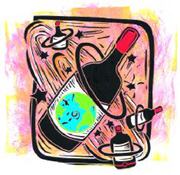As a gift, booze just can’t be beat. Whether it’s an obsequiously offered bottle of 21-year-old Glen Farclas for the boss or a forty of St. Ides slipped to your favorite street-dweller, alcohol’s almost universal appropriateness and—to borrow a word from our marketing friends—salability are unmatched in the gift-giving world. And, perhaps best of all, a strategically given bottle of hooch almost guarantees that you’ll get a few yuletide swigs of your own present. What other gift offers that kind of return? (“Hey, thanks for the scotch! Why don’t I just open this up right now?” Yes, an excellent idea, my pretty.)
But, as with all gifts, the real problem here is the appearance of forethought. The last thing you want is for your best friend to think that you just stopped by the liquor store on your way over, grabbed a bottle, slapped on a red bow, and called it a day. Where, they might ask fairly, is the love? Fortunately, liquor comes through again: While you were busy drinking, alcohol was weaving a rich global history, with poets and politicians—even entire nations— filling out the pages of liquor’s long and colorful story. You’re not giving mere booze; you’re giving the gift of culture. A bottle of rum is one thing; a bottle of 7-year-old Flor de Ca�rom Puerto Rico, accompanied by an aside about its popularity in colonial America and how it inspired such gut-burning 18th-century drinks as the Kill-Divil and the Whistle-Belly Bengance—that’s completely different, a gift to be remembered and treasured (and, with any luck, shared).
So what separates a culturally iconic bottle of booze from a gift-wrapped suitcase of Schmidt? Status. When looking for the cream of the booze crop, a good place to start is with alcohol that’s captivated the imagination and loyalty of a region or country. (Of course this same logic could justify giving a case of Schmidt, but use discretion when giving the brew that grew with the great Northwest.) National drinks are high-octane heavy-hitters, the hometown favorites that promise both quality and a good backstory.
A few obvious choices come immediately to mind: Going as far back as Czar Peter the Great, vodka has remained the antifreeze of choice on the bitter Russian tundra. A good bottle of colorless Stolichnaya Gold (750mL, $24.95) should satisfy any would-be MiG pilot or mafiya-type. Rum likewise makes an easy choice, especially among the “Arrrrr!” crowd, and a jug of Haitian Barbancourt or that 7-year-old Flor de Ca�both 750mL) will only set you back $19.95 or $20.75 respectively. (Just don’t forget to mention that Whistle-Belly Bengance.) Tequila, long ghettoized as the caustic frat-boy-rite-of-passage liquor, shines in its more delicate (and expensive) forms. Anyone who’s cursed Mexico’s most famous ambassador after an agave-soaked Apple Cup gone wrong deserves to sip from a smooth tumbler of Patr�Don Julio, Porfido, or El Grito (750mL, $39.95-$88.95). Augment your gift with a CD so Lucha Reyes can sing “La Borrachita de Tequila” (“Little Girl Drunkard of Tequila”) in the background while you explain the difference between silver (fresh from the still), reposado (“rested” in oak tanks or barrels from two months to a year), and a� (aged for at least a year in government-sealed barrels).
Your options get more interesting the further back you dig at the liquor store. An excellent bottle of pisco, the traditional drink of Spain’s Viceroyalty of Peru (still being swilled throughout contemporary Chile and Peru), goes well with a ceviche dinner, especially mixed up in a pisco sour (pisco plus egg whites, sugar, lemon, and bitters on ice). You can even get the distinctive red grape brandy in a cool bottle shaped like an Easter Island idol (750mL, $24.95).
If you’re shopping for a cheaper, more proletarian drunk, poor Brazilians recommend the ever-trendier cachaca (Portuguese for “burning water”)(1L, $19). Across the Atlantic, Italian grappa also hails from the kerosene-swilling hipster family of drinks, and a fiery bottle of Grappa Julia will only set you back $20.35 (750mL). Grappa virgins won’t have any trouble believing that this potent methyl alcohol treat comes from the garbage left over from making wine, but a slender vial of Grappa Poli ($60.35 for less than a pint) still makes a neat-looking gift.
Or you can bypass the liquor store completely and opt for something lower octane at Capitol Hill’s Stumbling Monk (1635-1/2 E Olive, 860-0916), easily this town’s best little beer store, which carries over 500 different brews from at least 40 different countries. In addition to being the original “Nectar of the Gods” and the world’s oldest alcoholic beverage, mead remains England’s national drink. You’ll be welcome at any holiday party with a bottle of Lurgashall’s Christmas mead (750mL, $13.99), complete with spices for mulling. (Samuel Pepys claimed that this “naturallest drink of the Country . . . keeps a humming of the brain.” How’s that for literary?) Or toasted, roasted Irish stout can be had in everything from cans ($1.49) to five-gallon kegs ($54), with a fine selection from Guinness, Beamish, Murphy’s, and even our own Pike brewery. Or cross the Channel for what’s been described as “the ultimate chick beer,” Belgium’s light, wheaty lambic. The Stumbling Monk carries this venerable beer from six of the 10 breweries in existence, from the tart, traditional Cantillon (750mL, $17.99) to the more fruity and popular Lindeman’s (750mL, $8.99).
Whatever you choose, just remember: You’ve put a lot of thought into it. And if you happen to be out shopping for me, that suitcase of Schmidt will do just fine. You don’t even have to wrap it.
Paul Hughes is a freelance writer and editor in Seattle.








